ACCT6006 Auditing: Dick Smith Electronics Going Concern Analysis
VerifiedAdded on 2023/06/08
|15
|3767
|400
Case Study
AI Summary
This case study delves into the auditing theory and practice surrounding the collapse of Dick Smith Electronics Ltd. It examines the company's history, reasons for its downfall, and potential breaches of Australian Accounting Standards by its directors. The analysis identifies key indicators that auditors should have considered to assess going concern risks, particularly through the review of the 2014/15 annual report. The document further explores the implications of the auditor's unmodified opinion and their potential liability, referencing relevant literature and standards. This assignment provides a comprehensive overview of the auditing challenges and responsibilities in the context of a major corporate failure.
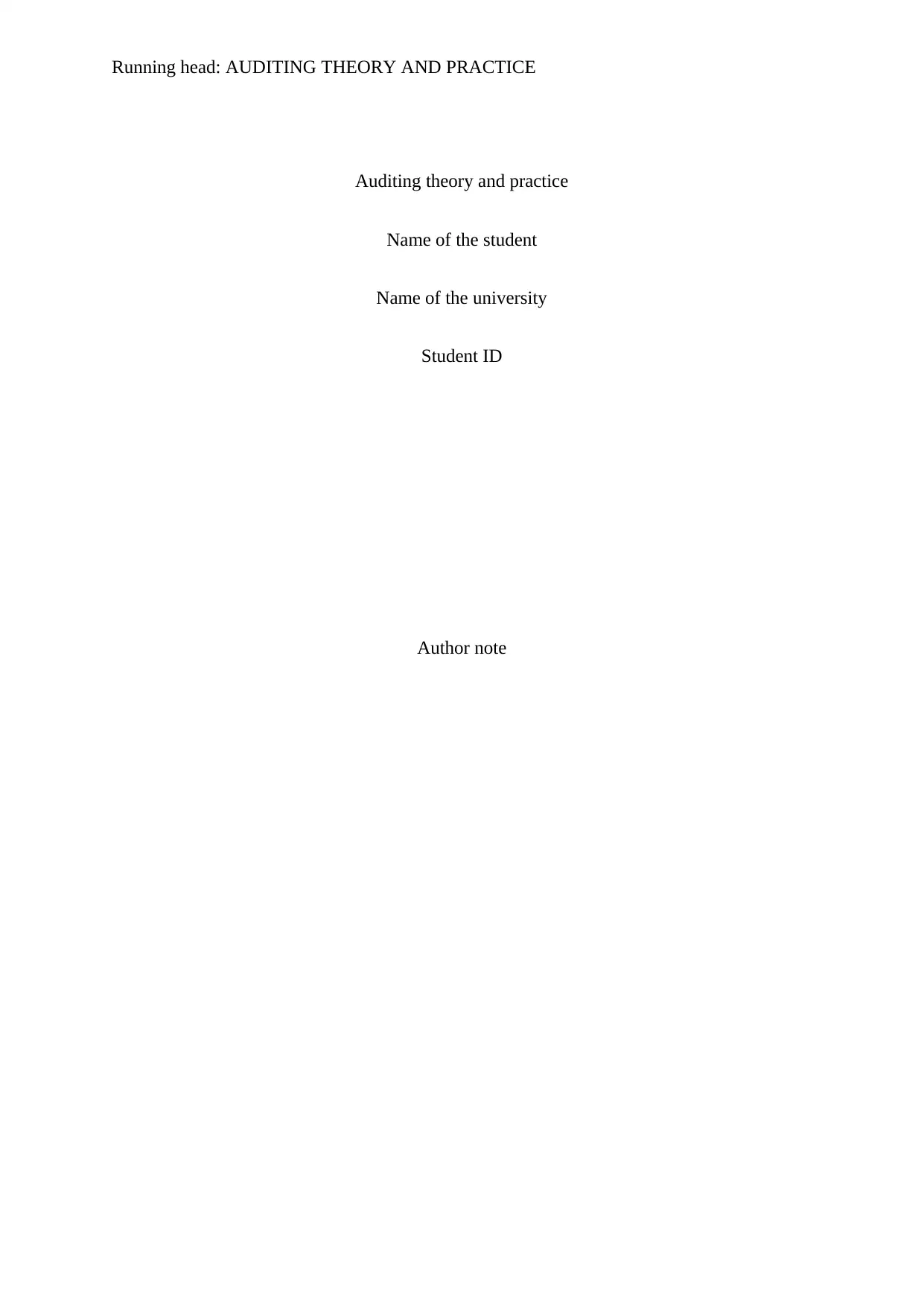
Running head: AUDITING THEORY AND PRACTICE
Auditing theory and practice
Name of the student
Name of the university
Student ID
Author note
Auditing theory and practice
Name of the student
Name of the university
Student ID
Author note
Paraphrase This Document
Need a fresh take? Get an instant paraphrase of this document with our AI Paraphraser
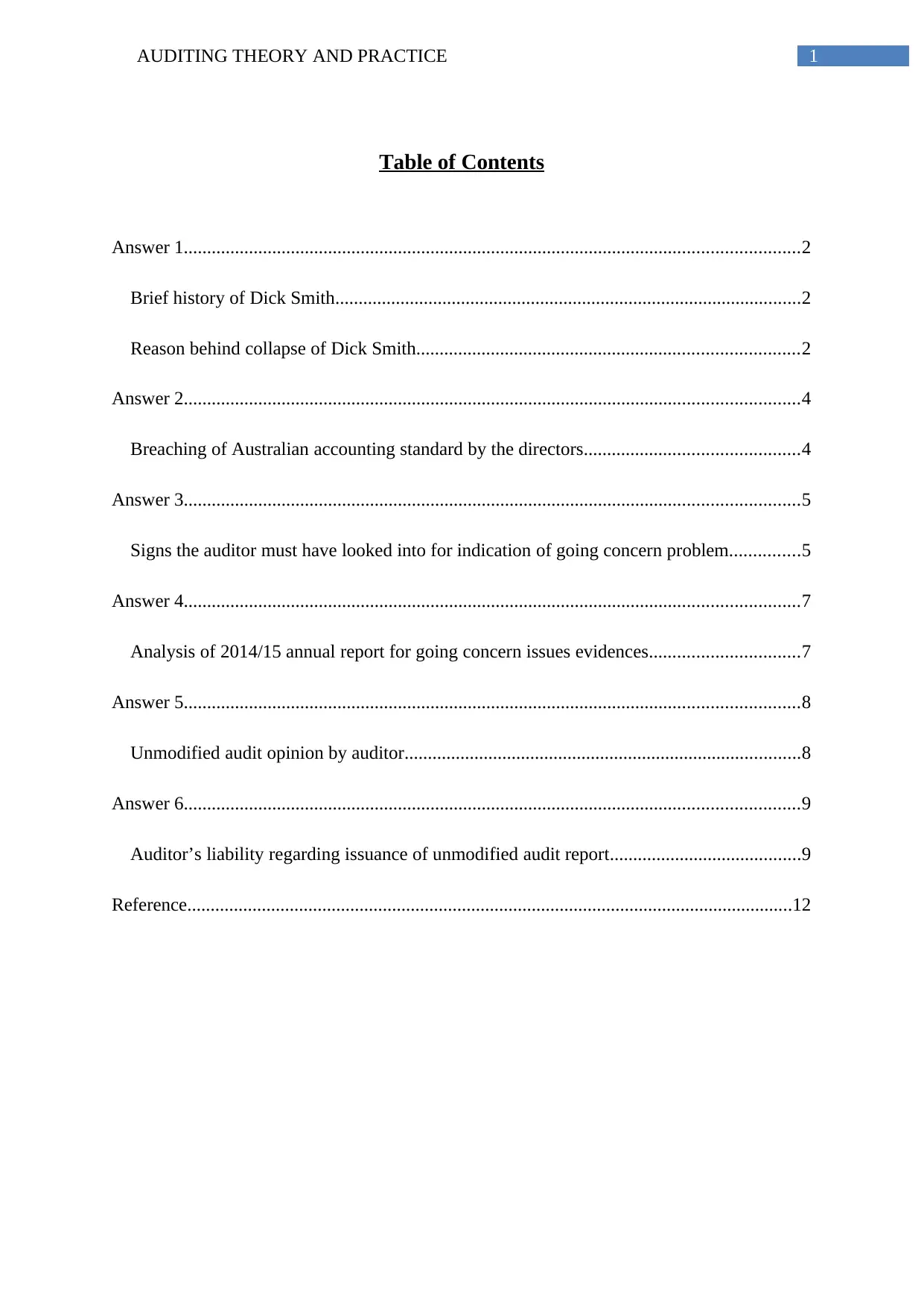
1AUDITING THEORY AND PRACTICE
Table of Contents
Answer 1....................................................................................................................................2
Brief history of Dick Smith....................................................................................................2
Reason behind collapse of Dick Smith..................................................................................2
Answer 2....................................................................................................................................4
Breaching of Australian accounting standard by the directors..............................................4
Answer 3....................................................................................................................................5
Signs the auditor must have looked into for indication of going concern problem...............5
Answer 4....................................................................................................................................7
Analysis of 2014/15 annual report for going concern issues evidences................................7
Answer 5....................................................................................................................................8
Unmodified audit opinion by auditor.....................................................................................8
Answer 6....................................................................................................................................9
Auditor’s liability regarding issuance of unmodified audit report.........................................9
Reference..................................................................................................................................12
Table of Contents
Answer 1....................................................................................................................................2
Brief history of Dick Smith....................................................................................................2
Reason behind collapse of Dick Smith..................................................................................2
Answer 2....................................................................................................................................4
Breaching of Australian accounting standard by the directors..............................................4
Answer 3....................................................................................................................................5
Signs the auditor must have looked into for indication of going concern problem...............5
Answer 4....................................................................................................................................7
Analysis of 2014/15 annual report for going concern issues evidences................................7
Answer 5....................................................................................................................................8
Unmodified audit opinion by auditor.....................................................................................8
Answer 6....................................................................................................................................9
Auditor’s liability regarding issuance of unmodified audit report.........................................9
Reference..................................................................................................................................12
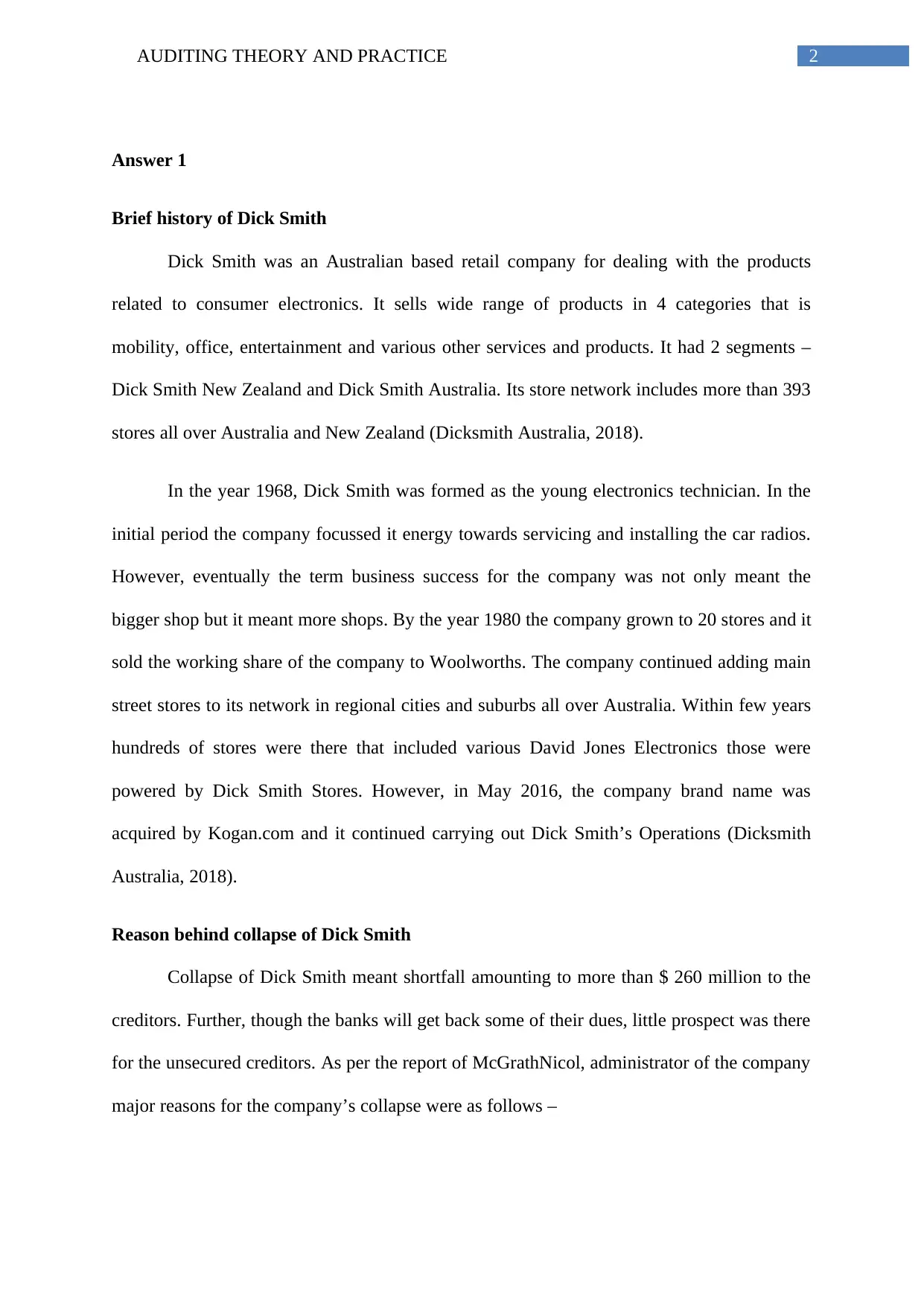
2AUDITING THEORY AND PRACTICE
Answer 1
Brief history of Dick Smith
Dick Smith was an Australian based retail company for dealing with the products
related to consumer electronics. It sells wide range of products in 4 categories that is
mobility, office, entertainment and various other services and products. It had 2 segments –
Dick Smith New Zealand and Dick Smith Australia. Its store network includes more than 393
stores all over Australia and New Zealand (Dicksmith Australia, 2018).
In the year 1968, Dick Smith was formed as the young electronics technician. In the
initial period the company focussed it energy towards servicing and installing the car radios.
However, eventually the term business success for the company was not only meant the
bigger shop but it meant more shops. By the year 1980 the company grown to 20 stores and it
sold the working share of the company to Woolworths. The company continued adding main
street stores to its network in regional cities and suburbs all over Australia. Within few years
hundreds of stores were there that included various David Jones Electronics those were
powered by Dick Smith Stores. However, in May 2016, the company brand name was
acquired by Kogan.com and it continued carrying out Dick Smith’s Operations (Dicksmith
Australia, 2018).
Reason behind collapse of Dick Smith
Collapse of Dick Smith meant shortfall amounting to more than $ 260 million to the
creditors. Further, though the banks will get back some of their dues, little prospect was there
for the unsecured creditors. As per the report of McGrathNicol, administrator of the company
major reasons for the company’s collapse were as follows –
Answer 1
Brief history of Dick Smith
Dick Smith was an Australian based retail company for dealing with the products
related to consumer electronics. It sells wide range of products in 4 categories that is
mobility, office, entertainment and various other services and products. It had 2 segments –
Dick Smith New Zealand and Dick Smith Australia. Its store network includes more than 393
stores all over Australia and New Zealand (Dicksmith Australia, 2018).
In the year 1968, Dick Smith was formed as the young electronics technician. In the
initial period the company focussed it energy towards servicing and installing the car radios.
However, eventually the term business success for the company was not only meant the
bigger shop but it meant more shops. By the year 1980 the company grown to 20 stores and it
sold the working share of the company to Woolworths. The company continued adding main
street stores to its network in regional cities and suburbs all over Australia. Within few years
hundreds of stores were there that included various David Jones Electronics those were
powered by Dick Smith Stores. However, in May 2016, the company brand name was
acquired by Kogan.com and it continued carrying out Dick Smith’s Operations (Dicksmith
Australia, 2018).
Reason behind collapse of Dick Smith
Collapse of Dick Smith meant shortfall amounting to more than $ 260 million to the
creditors. Further, though the banks will get back some of their dues, little prospect was there
for the unsecured creditors. As per the report of McGrathNicol, administrator of the company
major reasons for the company’s collapse were as follows –
⊘ This is a preview!⊘
Do you want full access?
Subscribe today to unlock all pages.

Trusted by 1+ million students worldwide

3AUDITING THEORY AND PRACTICE
Changes in the network – market for the consumer electronics are highly competitive
with fast changes in the pattern of consumer demand.
High cost for network store – the company had the store network that was
significantly larger as compared to its competitors. Therefore, the base of higher cost
with the considerable exposure and reliance towards the market of computer products
and fast moving office product led to involvement of higher level of cost
(SmartCompany, 2016).
Too fast – expansion plan needed significant commitment for finance, utilisation of
entire cash resources. It further required significant commitment from suppliers and
bank borrowings.
Fall in sales and shrinking of market share – growth in revenue was based on the
growth of stores and sales of commercials at the low margins
Sales of the company did not work – company’s clearance sales did not created
sufficient margin or sales for alleviating the pressure of cash.
Too much on the shelves – decisions regarding inventories made under the existing
environment were not regular with regard to the demand of the consumers. Ultimately
the company was left with significant level of inactive and obsolete stock that
required considerable write – down (SmartCompany, 2016).
Too expensive cost of finance – the company was not able raise finance with
favourable terms of credit. It had an impact on the product mix, store presentation and
stock levels.
Demand for loan was crushing – pressure with regard to cash flow led the company
towards banking covenants for breaching and it was not repairable (SmartCompany,
2016).
Changes in the network – market for the consumer electronics are highly competitive
with fast changes in the pattern of consumer demand.
High cost for network store – the company had the store network that was
significantly larger as compared to its competitors. Therefore, the base of higher cost
with the considerable exposure and reliance towards the market of computer products
and fast moving office product led to involvement of higher level of cost
(SmartCompany, 2016).
Too fast – expansion plan needed significant commitment for finance, utilisation of
entire cash resources. It further required significant commitment from suppliers and
bank borrowings.
Fall in sales and shrinking of market share – growth in revenue was based on the
growth of stores and sales of commercials at the low margins
Sales of the company did not work – company’s clearance sales did not created
sufficient margin or sales for alleviating the pressure of cash.
Too much on the shelves – decisions regarding inventories made under the existing
environment were not regular with regard to the demand of the consumers. Ultimately
the company was left with significant level of inactive and obsolete stock that
required considerable write – down (SmartCompany, 2016).
Too expensive cost of finance – the company was not able raise finance with
favourable terms of credit. It had an impact on the product mix, store presentation and
stock levels.
Demand for loan was crushing – pressure with regard to cash flow led the company
towards banking covenants for breaching and it was not repairable (SmartCompany,
2016).
Paraphrase This Document
Need a fresh take? Get an instant paraphrase of this document with our AI Paraphraser
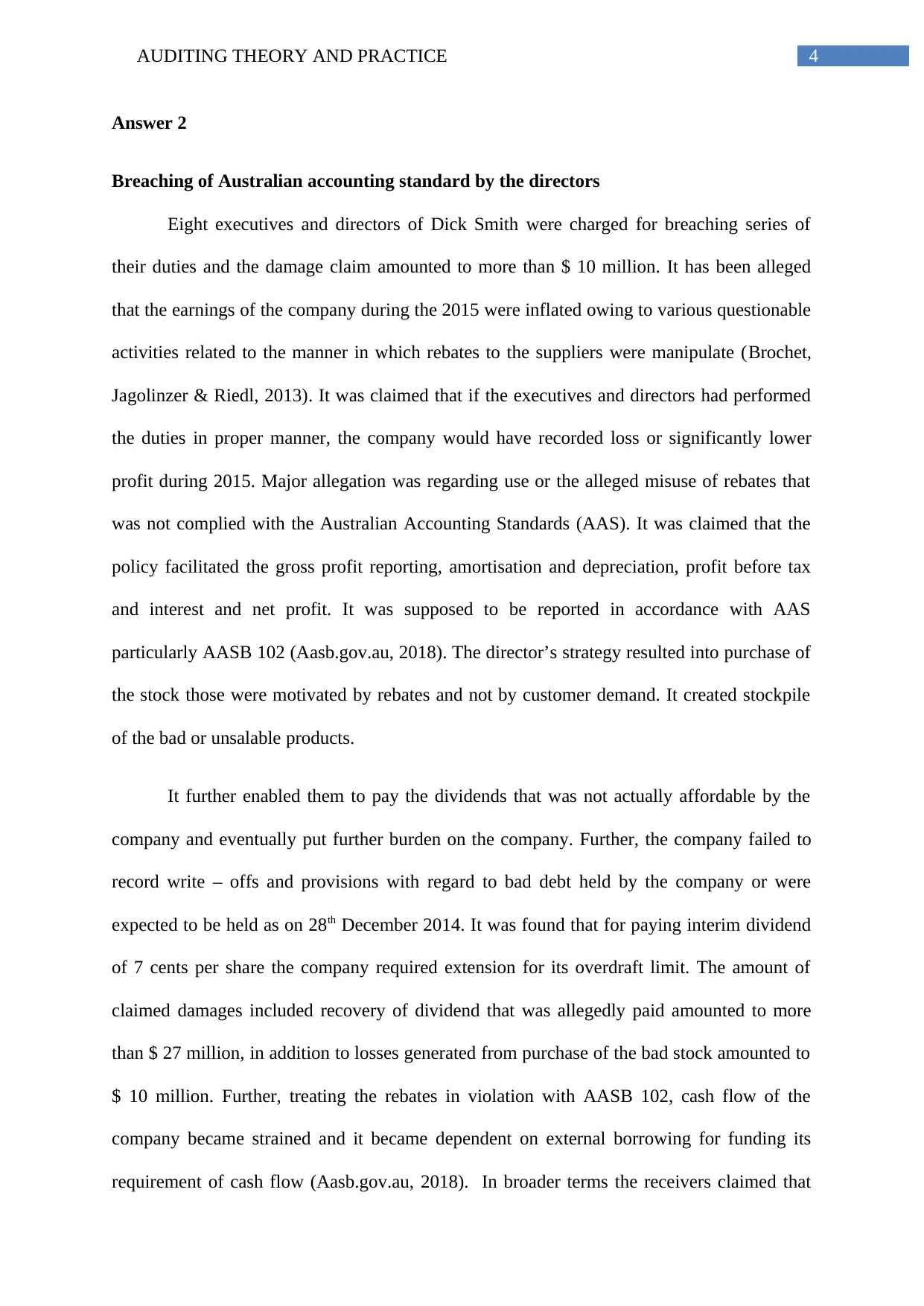
4AUDITING THEORY AND PRACTICE
Answer 2
Breaching of Australian accounting standard by the directors
Eight executives and directors of Dick Smith were charged for breaching series of
their duties and the damage claim amounted to more than $ 10 million. It has been alleged
that the earnings of the company during the 2015 were inflated owing to various questionable
activities related to the manner in which rebates to the suppliers were manipulate (Brochet,
Jagolinzer & Riedl, 2013). It was claimed that if the executives and directors had performed
the duties in proper manner, the company would have recorded loss or significantly lower
profit during 2015. Major allegation was regarding use or the alleged misuse of rebates that
was not complied with the Australian Accounting Standards (AAS). It was claimed that the
policy facilitated the gross profit reporting, amortisation and depreciation, profit before tax
and interest and net profit. It was supposed to be reported in accordance with AAS
particularly AASB 102 (Aasb.gov.au, 2018). The director’s strategy resulted into purchase of
the stock those were motivated by rebates and not by customer demand. It created stockpile
of the bad or unsalable products.
It further enabled them to pay the dividends that was not actually affordable by the
company and eventually put further burden on the company. Further, the company failed to
record write – offs and provisions with regard to bad debt held by the company or were
expected to be held as on 28th December 2014. It was found that for paying interim dividend
of 7 cents per share the company required extension for its overdraft limit. The amount of
claimed damages included recovery of dividend that was allegedly paid amounted to more
than $ 27 million, in addition to losses generated from purchase of the bad stock amounted to
$ 10 million. Further, treating the rebates in violation with AASB 102, cash flow of the
company became strained and it became dependent on external borrowing for funding its
requirement of cash flow (Aasb.gov.au, 2018). In broader terms the receivers claimed that
Answer 2
Breaching of Australian accounting standard by the directors
Eight executives and directors of Dick Smith were charged for breaching series of
their duties and the damage claim amounted to more than $ 10 million. It has been alleged
that the earnings of the company during the 2015 were inflated owing to various questionable
activities related to the manner in which rebates to the suppliers were manipulate (Brochet,
Jagolinzer & Riedl, 2013). It was claimed that if the executives and directors had performed
the duties in proper manner, the company would have recorded loss or significantly lower
profit during 2015. Major allegation was regarding use or the alleged misuse of rebates that
was not complied with the Australian Accounting Standards (AAS). It was claimed that the
policy facilitated the gross profit reporting, amortisation and depreciation, profit before tax
and interest and net profit. It was supposed to be reported in accordance with AAS
particularly AASB 102 (Aasb.gov.au, 2018). The director’s strategy resulted into purchase of
the stock those were motivated by rebates and not by customer demand. It created stockpile
of the bad or unsalable products.
It further enabled them to pay the dividends that was not actually affordable by the
company and eventually put further burden on the company. Further, the company failed to
record write – offs and provisions with regard to bad debt held by the company or were
expected to be held as on 28th December 2014. It was found that for paying interim dividend
of 7 cents per share the company required extension for its overdraft limit. The amount of
claimed damages included recovery of dividend that was allegedly paid amounted to more
than $ 27 million, in addition to losses generated from purchase of the bad stock amounted to
$ 10 million. Further, treating the rebates in violation with AASB 102, cash flow of the
company became strained and it became dependent on external borrowing for funding its
requirement of cash flow (Aasb.gov.au, 2018). In broader terms the receivers claimed that
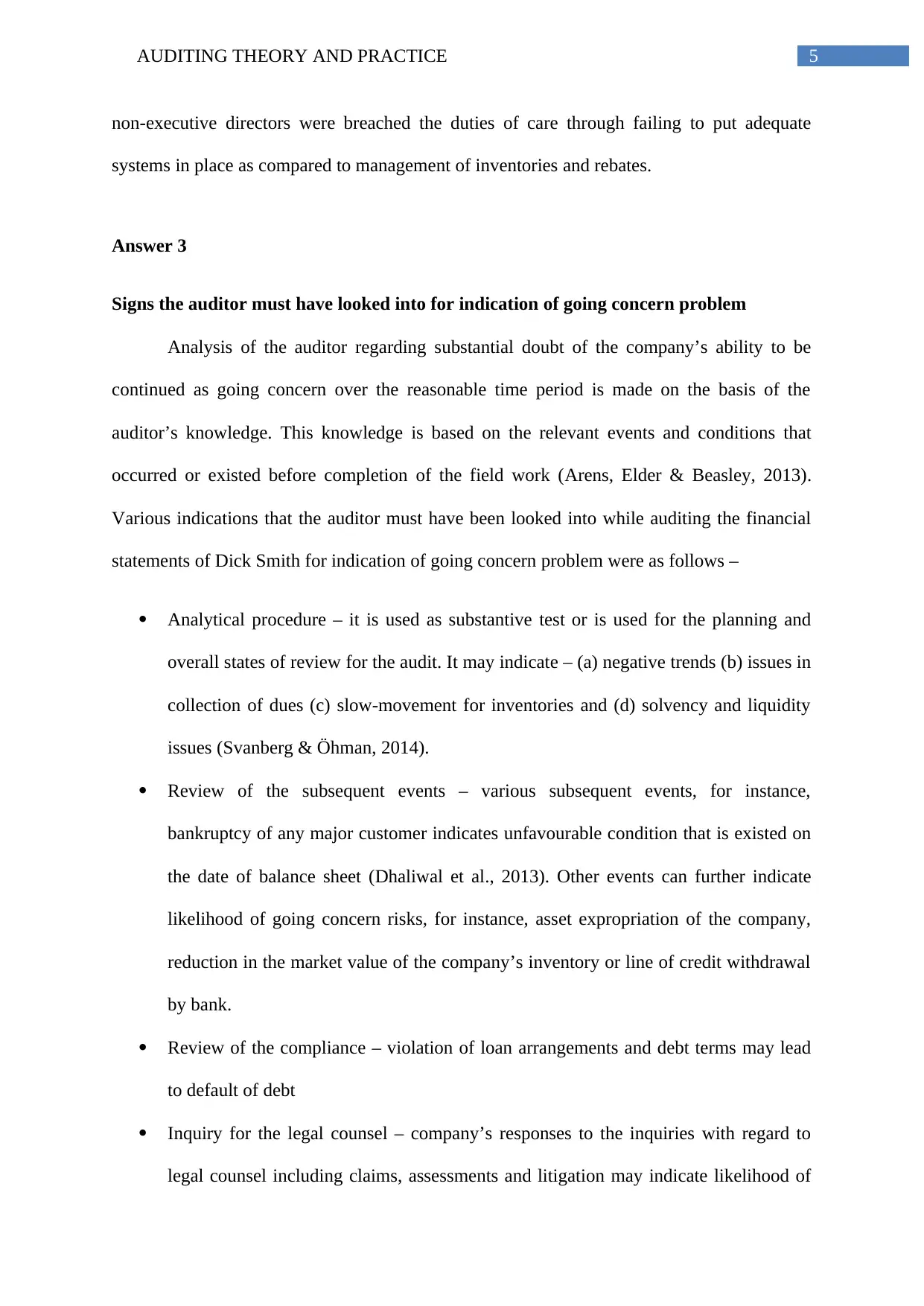
5AUDITING THEORY AND PRACTICE
non-executive directors were breached the duties of care through failing to put adequate
systems in place as compared to management of inventories and rebates.
Answer 3
Signs the auditor must have looked into for indication of going concern problem
Analysis of the auditor regarding substantial doubt of the company’s ability to be
continued as going concern over the reasonable time period is made on the basis of the
auditor’s knowledge. This knowledge is based on the relevant events and conditions that
occurred or existed before completion of the field work (Arens, Elder & Beasley, 2013).
Various indications that the auditor must have been looked into while auditing the financial
statements of Dick Smith for indication of going concern problem were as follows –
Analytical procedure – it is used as substantive test or is used for the planning and
overall states of review for the audit. It may indicate – (a) negative trends (b) issues in
collection of dues (c) slow-movement for inventories and (d) solvency and liquidity
issues (Svanberg & Öhman, 2014).
Review of the subsequent events – various subsequent events, for instance,
bankruptcy of any major customer indicates unfavourable condition that is existed on
the date of balance sheet (Dhaliwal et al., 2013). Other events can further indicate
likelihood of going concern risks, for instance, asset expropriation of the company,
reduction in the market value of the company’s inventory or line of credit withdrawal
by bank.
Review of the compliance – violation of loan arrangements and debt terms may lead
to default of debt
Inquiry for the legal counsel – company’s responses to the inquiries with regard to
legal counsel including claims, assessments and litigation may indicate likelihood of
non-executive directors were breached the duties of care through failing to put adequate
systems in place as compared to management of inventories and rebates.
Answer 3
Signs the auditor must have looked into for indication of going concern problem
Analysis of the auditor regarding substantial doubt of the company’s ability to be
continued as going concern over the reasonable time period is made on the basis of the
auditor’s knowledge. This knowledge is based on the relevant events and conditions that
occurred or existed before completion of the field work (Arens, Elder & Beasley, 2013).
Various indications that the auditor must have been looked into while auditing the financial
statements of Dick Smith for indication of going concern problem were as follows –
Analytical procedure – it is used as substantive test or is used for the planning and
overall states of review for the audit. It may indicate – (a) negative trends (b) issues in
collection of dues (c) slow-movement for inventories and (d) solvency and liquidity
issues (Svanberg & Öhman, 2014).
Review of the subsequent events – various subsequent events, for instance,
bankruptcy of any major customer indicates unfavourable condition that is existed on
the date of balance sheet (Dhaliwal et al., 2013). Other events can further indicate
likelihood of going concern risks, for instance, asset expropriation of the company,
reduction in the market value of the company’s inventory or line of credit withdrawal
by bank.
Review of the compliance – violation of loan arrangements and debt terms may lead
to default of debt
Inquiry for the legal counsel – company’s responses to the inquiries with regard to
legal counsel including claims, assessments and litigation may indicate likelihood of
⊘ This is a preview!⊘
Do you want full access?
Subscribe today to unlock all pages.

Trusted by 1+ million students worldwide
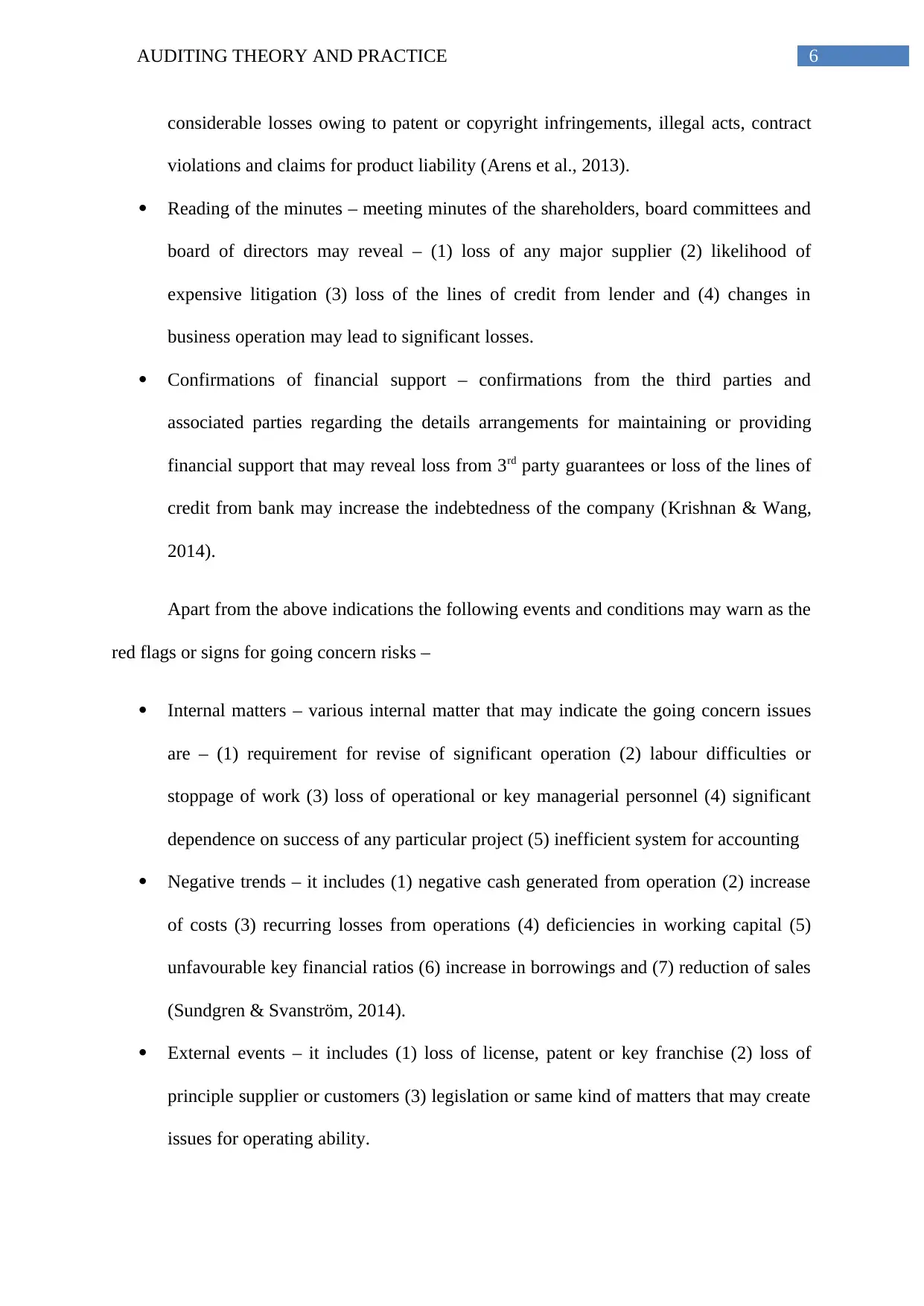
6AUDITING THEORY AND PRACTICE
considerable losses owing to patent or copyright infringements, illegal acts, contract
violations and claims for product liability (Arens et al., 2013).
Reading of the minutes – meeting minutes of the shareholders, board committees and
board of directors may reveal – (1) loss of any major supplier (2) likelihood of
expensive litigation (3) loss of the lines of credit from lender and (4) changes in
business operation may lead to significant losses.
Confirmations of financial support – confirmations from the third parties and
associated parties regarding the details arrangements for maintaining or providing
financial support that may reveal loss from 3rd party guarantees or loss of the lines of
credit from bank may increase the indebtedness of the company (Krishnan & Wang,
2014).
Apart from the above indications the following events and conditions may warn as the
red flags or signs for going concern risks –
Internal matters – various internal matter that may indicate the going concern issues
are – (1) requirement for revise of significant operation (2) labour difficulties or
stoppage of work (3) loss of operational or key managerial personnel (4) significant
dependence on success of any particular project (5) inefficient system for accounting
Negative trends – it includes (1) negative cash generated from operation (2) increase
of costs (3) recurring losses from operations (4) deficiencies in working capital (5)
unfavourable key financial ratios (6) increase in borrowings and (7) reduction of sales
(Sundgren & Svanström, 2014).
External events – it includes (1) loss of license, patent or key franchise (2) loss of
principle supplier or customers (3) legislation or same kind of matters that may create
issues for operating ability.
considerable losses owing to patent or copyright infringements, illegal acts, contract
violations and claims for product liability (Arens et al., 2013).
Reading of the minutes – meeting minutes of the shareholders, board committees and
board of directors may reveal – (1) loss of any major supplier (2) likelihood of
expensive litigation (3) loss of the lines of credit from lender and (4) changes in
business operation may lead to significant losses.
Confirmations of financial support – confirmations from the third parties and
associated parties regarding the details arrangements for maintaining or providing
financial support that may reveal loss from 3rd party guarantees or loss of the lines of
credit from bank may increase the indebtedness of the company (Krishnan & Wang,
2014).
Apart from the above indications the following events and conditions may warn as the
red flags or signs for going concern risks –
Internal matters – various internal matter that may indicate the going concern issues
are – (1) requirement for revise of significant operation (2) labour difficulties or
stoppage of work (3) loss of operational or key managerial personnel (4) significant
dependence on success of any particular project (5) inefficient system for accounting
Negative trends – it includes (1) negative cash generated from operation (2) increase
of costs (3) recurring losses from operations (4) deficiencies in working capital (5)
unfavourable key financial ratios (6) increase in borrowings and (7) reduction of sales
(Sundgren & Svanström, 2014).
External events – it includes (1) loss of license, patent or key franchise (2) loss of
principle supplier or customers (3) legislation or same kind of matters that may create
issues for operating ability.
Paraphrase This Document
Need a fresh take? Get an instant paraphrase of this document with our AI Paraphraser
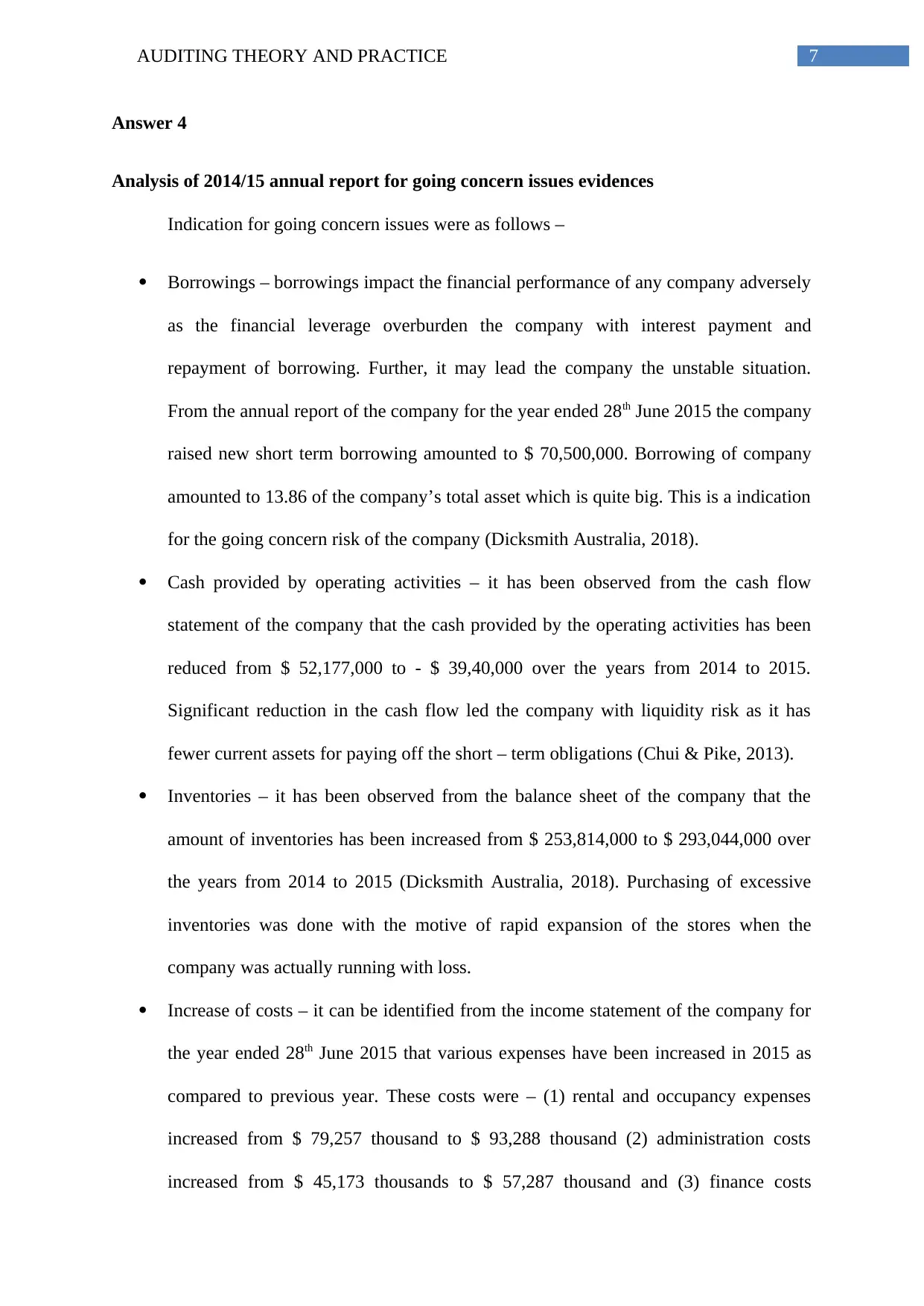
7AUDITING THEORY AND PRACTICE
Answer 4
Analysis of 2014/15 annual report for going concern issues evidences
Indication for going concern issues were as follows –
Borrowings – borrowings impact the financial performance of any company adversely
as the financial leverage overburden the company with interest payment and
repayment of borrowing. Further, it may lead the company the unstable situation.
From the annual report of the company for the year ended 28th June 2015 the company
raised new short term borrowing amounted to $ 70,500,000. Borrowing of company
amounted to 13.86 of the company’s total asset which is quite big. This is a indication
for the going concern risk of the company (Dicksmith Australia, 2018).
Cash provided by operating activities – it has been observed from the cash flow
statement of the company that the cash provided by the operating activities has been
reduced from $ 52,177,000 to - $ 39,40,000 over the years from 2014 to 2015.
Significant reduction in the cash flow led the company with liquidity risk as it has
fewer current assets for paying off the short – term obligations (Chui & Pike, 2013).
Inventories – it has been observed from the balance sheet of the company that the
amount of inventories has been increased from $ 253,814,000 to $ 293,044,000 over
the years from 2014 to 2015 (Dicksmith Australia, 2018). Purchasing of excessive
inventories was done with the motive of rapid expansion of the stores when the
company was actually running with loss.
Increase of costs – it can be identified from the income statement of the company for
the year ended 28th June 2015 that various expenses have been increased in 2015 as
compared to previous year. These costs were – (1) rental and occupancy expenses
increased from $ 79,257 thousand to $ 93,288 thousand (2) administration costs
increased from $ 45,173 thousands to $ 57,287 thousand and (3) finance costs
Answer 4
Analysis of 2014/15 annual report for going concern issues evidences
Indication for going concern issues were as follows –
Borrowings – borrowings impact the financial performance of any company adversely
as the financial leverage overburden the company with interest payment and
repayment of borrowing. Further, it may lead the company the unstable situation.
From the annual report of the company for the year ended 28th June 2015 the company
raised new short term borrowing amounted to $ 70,500,000. Borrowing of company
amounted to 13.86 of the company’s total asset which is quite big. This is a indication
for the going concern risk of the company (Dicksmith Australia, 2018).
Cash provided by operating activities – it has been observed from the cash flow
statement of the company that the cash provided by the operating activities has been
reduced from $ 52,177,000 to - $ 39,40,000 over the years from 2014 to 2015.
Significant reduction in the cash flow led the company with liquidity risk as it has
fewer current assets for paying off the short – term obligations (Chui & Pike, 2013).
Inventories – it has been observed from the balance sheet of the company that the
amount of inventories has been increased from $ 253,814,000 to $ 293,044,000 over
the years from 2014 to 2015 (Dicksmith Australia, 2018). Purchasing of excessive
inventories was done with the motive of rapid expansion of the stores when the
company was actually running with loss.
Increase of costs – it can be identified from the income statement of the company for
the year ended 28th June 2015 that various expenses have been increased in 2015 as
compared to previous year. These costs were – (1) rental and occupancy expenses
increased from $ 79,257 thousand to $ 93,288 thousand (2) administration costs
increased from $ 45,173 thousands to $ 57,287 thousand and (3) finance costs
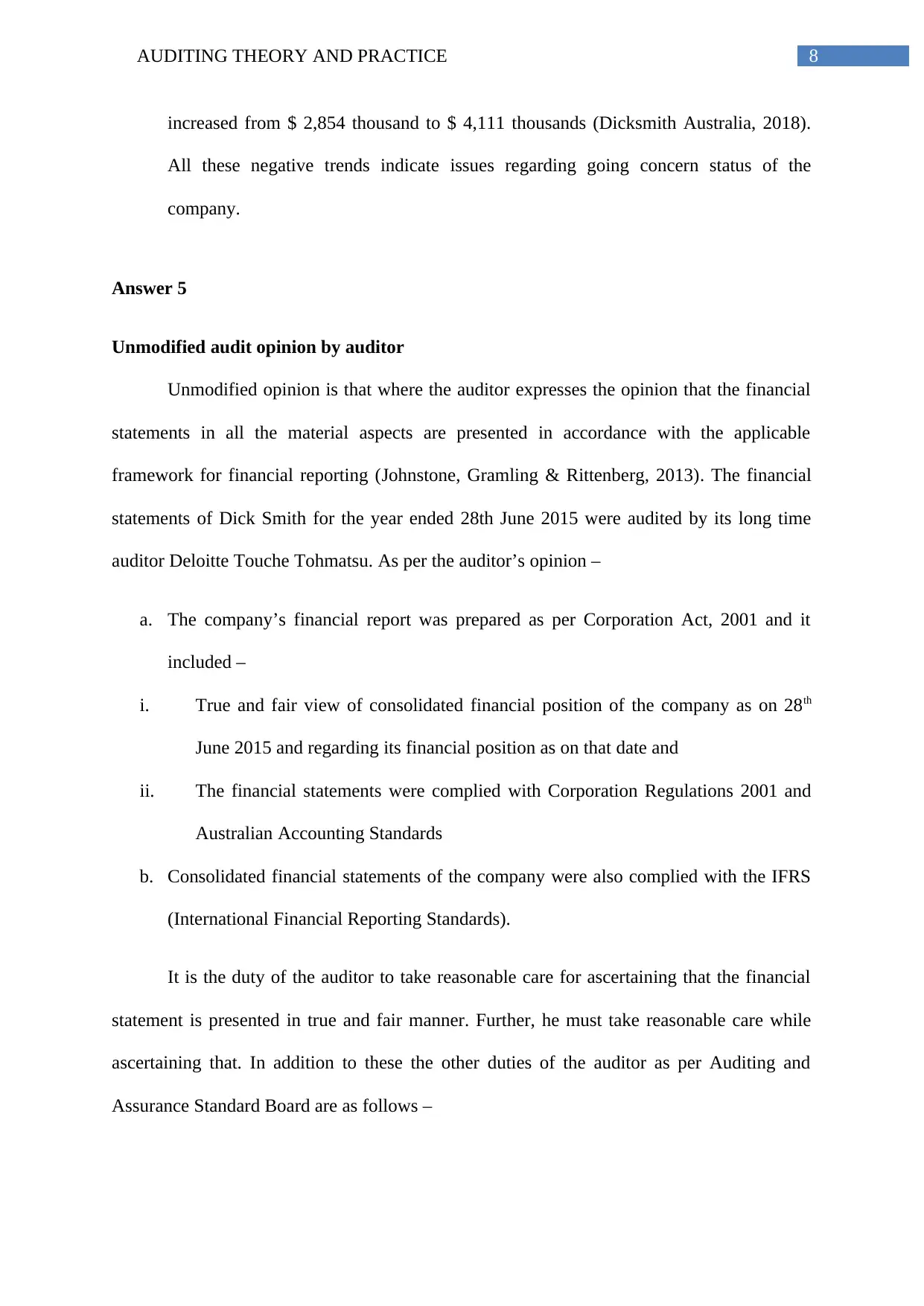
8AUDITING THEORY AND PRACTICE
increased from $ 2,854 thousand to $ 4,111 thousands (Dicksmith Australia, 2018).
All these negative trends indicate issues regarding going concern status of the
company.
Answer 5
Unmodified audit opinion by auditor
Unmodified opinion is that where the auditor expresses the opinion that the financial
statements in all the material aspects are presented in accordance with the applicable
framework for financial reporting (Johnstone, Gramling & Rittenberg, 2013). The financial
statements of Dick Smith for the year ended 28th June 2015 were audited by its long time
auditor Deloitte Touche Tohmatsu. As per the auditor’s opinion –
a. The company’s financial report was prepared as per Corporation Act, 2001 and it
included –
i. True and fair view of consolidated financial position of the company as on 28th
June 2015 and regarding its financial position as on that date and
ii. The financial statements were complied with Corporation Regulations 2001 and
Australian Accounting Standards
b. Consolidated financial statements of the company were also complied with the IFRS
(International Financial Reporting Standards).
It is the duty of the auditor to take reasonable care for ascertaining that the financial
statement is presented in true and fair manner. Further, he must take reasonable care while
ascertaining that. In addition to these the other duties of the auditor as per Auditing and
Assurance Standard Board are as follows –
increased from $ 2,854 thousand to $ 4,111 thousands (Dicksmith Australia, 2018).
All these negative trends indicate issues regarding going concern status of the
company.
Answer 5
Unmodified audit opinion by auditor
Unmodified opinion is that where the auditor expresses the opinion that the financial
statements in all the material aspects are presented in accordance with the applicable
framework for financial reporting (Johnstone, Gramling & Rittenberg, 2013). The financial
statements of Dick Smith for the year ended 28th June 2015 were audited by its long time
auditor Deloitte Touche Tohmatsu. As per the auditor’s opinion –
a. The company’s financial report was prepared as per Corporation Act, 2001 and it
included –
i. True and fair view of consolidated financial position of the company as on 28th
June 2015 and regarding its financial position as on that date and
ii. The financial statements were complied with Corporation Regulations 2001 and
Australian Accounting Standards
b. Consolidated financial statements of the company were also complied with the IFRS
(International Financial Reporting Standards).
It is the duty of the auditor to take reasonable care for ascertaining that the financial
statement is presented in true and fair manner. Further, he must take reasonable care while
ascertaining that. In addition to these the other duties of the auditor as per Auditing and
Assurance Standard Board are as follows –
⊘ This is a preview!⊘
Do you want full access?
Subscribe today to unlock all pages.

Trusted by 1+ million students worldwide
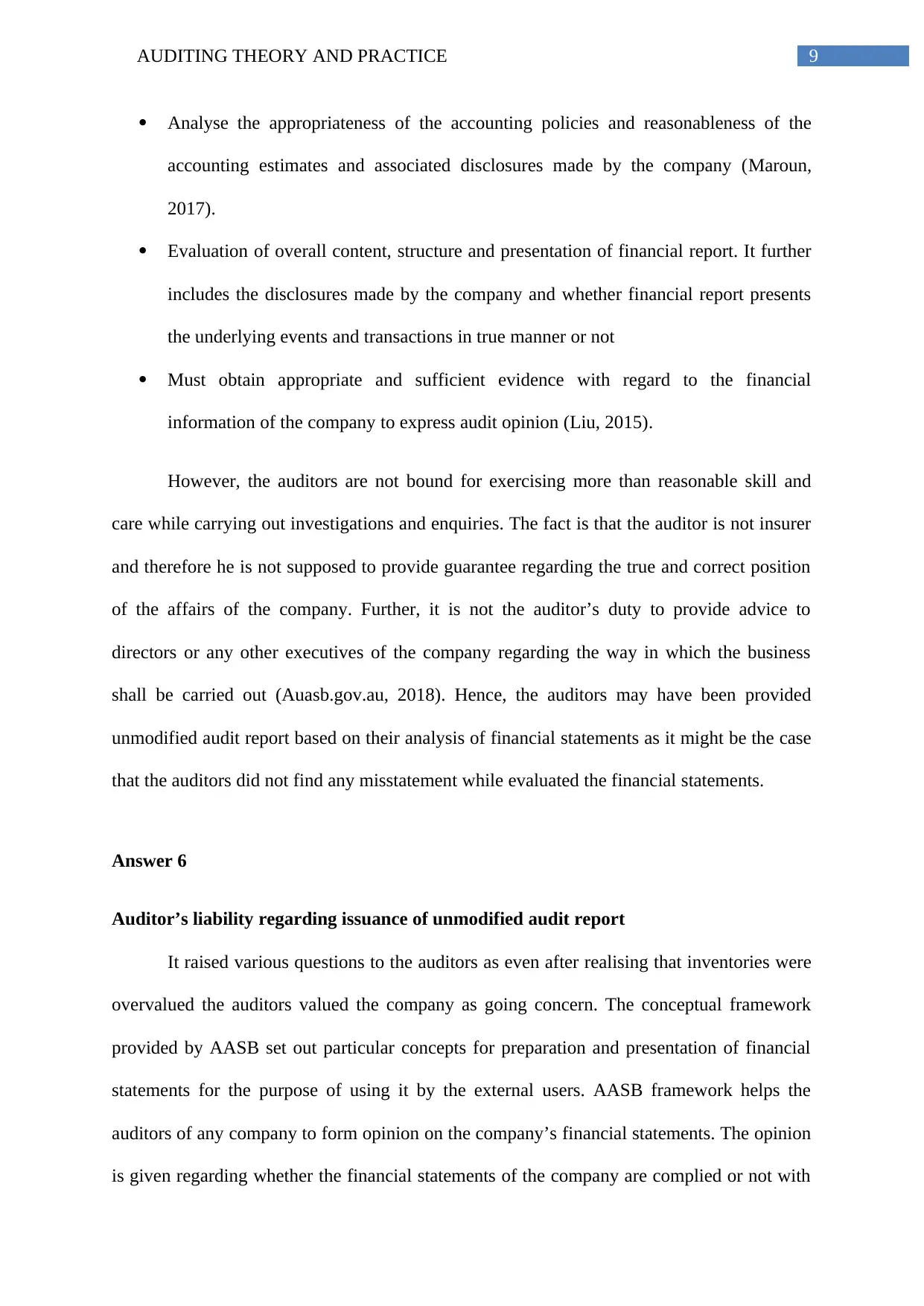
9AUDITING THEORY AND PRACTICE
Analyse the appropriateness of the accounting policies and reasonableness of the
accounting estimates and associated disclosures made by the company (Maroun,
2017).
Evaluation of overall content, structure and presentation of financial report. It further
includes the disclosures made by the company and whether financial report presents
the underlying events and transactions in true manner or not
Must obtain appropriate and sufficient evidence with regard to the financial
information of the company to express audit opinion (Liu, 2015).
However, the auditors are not bound for exercising more than reasonable skill and
care while carrying out investigations and enquiries. The fact is that the auditor is not insurer
and therefore he is not supposed to provide guarantee regarding the true and correct position
of the affairs of the company. Further, it is not the auditor’s duty to provide advice to
directors or any other executives of the company regarding the way in which the business
shall be carried out (Auasb.gov.au, 2018). Hence, the auditors may have been provided
unmodified audit report based on their analysis of financial statements as it might be the case
that the auditors did not find any misstatement while evaluated the financial statements.
Answer 6
Auditor’s liability regarding issuance of unmodified audit report
It raised various questions to the auditors as even after realising that inventories were
overvalued the auditors valued the company as going concern. The conceptual framework
provided by AASB set out particular concepts for preparation and presentation of financial
statements for the purpose of using it by the external users. AASB framework helps the
auditors of any company to form opinion on the company’s financial statements. The opinion
is given regarding whether the financial statements of the company are complied or not with
Analyse the appropriateness of the accounting policies and reasonableness of the
accounting estimates and associated disclosures made by the company (Maroun,
2017).
Evaluation of overall content, structure and presentation of financial report. It further
includes the disclosures made by the company and whether financial report presents
the underlying events and transactions in true manner or not
Must obtain appropriate and sufficient evidence with regard to the financial
information of the company to express audit opinion (Liu, 2015).
However, the auditors are not bound for exercising more than reasonable skill and
care while carrying out investigations and enquiries. The fact is that the auditor is not insurer
and therefore he is not supposed to provide guarantee regarding the true and correct position
of the affairs of the company. Further, it is not the auditor’s duty to provide advice to
directors or any other executives of the company regarding the way in which the business
shall be carried out (Auasb.gov.au, 2018). Hence, the auditors may have been provided
unmodified audit report based on their analysis of financial statements as it might be the case
that the auditors did not find any misstatement while evaluated the financial statements.
Answer 6
Auditor’s liability regarding issuance of unmodified audit report
It raised various questions to the auditors as even after realising that inventories were
overvalued the auditors valued the company as going concern. The conceptual framework
provided by AASB set out particular concepts for preparation and presentation of financial
statements for the purpose of using it by the external users. AASB framework helps the
auditors of any company to form opinion on the company’s financial statements. The opinion
is given regarding whether the financial statements of the company are complied or not with
Paraphrase This Document
Need a fresh take? Get an instant paraphrase of this document with our AI Paraphraser
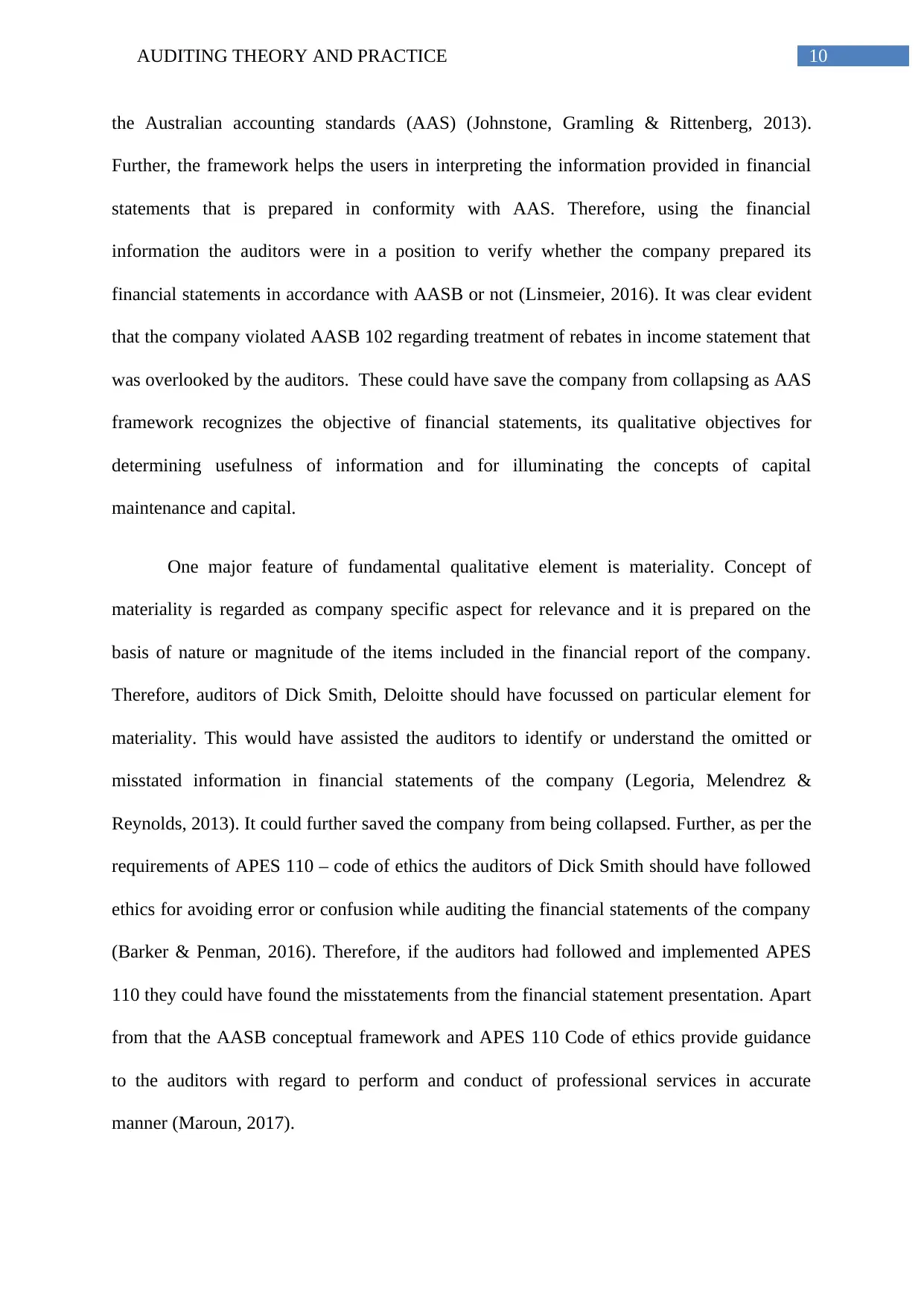
10AUDITING THEORY AND PRACTICE
the Australian accounting standards (AAS) (Johnstone, Gramling & Rittenberg, 2013).
Further, the framework helps the users in interpreting the information provided in financial
statements that is prepared in conformity with AAS. Therefore, using the financial
information the auditors were in a position to verify whether the company prepared its
financial statements in accordance with AASB or not (Linsmeier, 2016). It was clear evident
that the company violated AASB 102 regarding treatment of rebates in income statement that
was overlooked by the auditors. These could have save the company from collapsing as AAS
framework recognizes the objective of financial statements, its qualitative objectives for
determining usefulness of information and for illuminating the concepts of capital
maintenance and capital.
One major feature of fundamental qualitative element is materiality. Concept of
materiality is regarded as company specific aspect for relevance and it is prepared on the
basis of nature or magnitude of the items included in the financial report of the company.
Therefore, auditors of Dick Smith, Deloitte should have focussed on particular element for
materiality. This would have assisted the auditors to identify or understand the omitted or
misstated information in financial statements of the company (Legoria, Melendrez &
Reynolds, 2013). It could further saved the company from being collapsed. Further, as per the
requirements of APES 110 – code of ethics the auditors of Dick Smith should have followed
ethics for avoiding error or confusion while auditing the financial statements of the company
(Barker & Penman, 2016). Therefore, if the auditors had followed and implemented APES
110 they could have found the misstatements from the financial statement presentation. Apart
from that the AASB conceptual framework and APES 110 Code of ethics provide guidance
to the auditors with regard to perform and conduct of professional services in accurate
manner (Maroun, 2017).
the Australian accounting standards (AAS) (Johnstone, Gramling & Rittenberg, 2013).
Further, the framework helps the users in interpreting the information provided in financial
statements that is prepared in conformity with AAS. Therefore, using the financial
information the auditors were in a position to verify whether the company prepared its
financial statements in accordance with AASB or not (Linsmeier, 2016). It was clear evident
that the company violated AASB 102 regarding treatment of rebates in income statement that
was overlooked by the auditors. These could have save the company from collapsing as AAS
framework recognizes the objective of financial statements, its qualitative objectives for
determining usefulness of information and for illuminating the concepts of capital
maintenance and capital.
One major feature of fundamental qualitative element is materiality. Concept of
materiality is regarded as company specific aspect for relevance and it is prepared on the
basis of nature or magnitude of the items included in the financial report of the company.
Therefore, auditors of Dick Smith, Deloitte should have focussed on particular element for
materiality. This would have assisted the auditors to identify or understand the omitted or
misstated information in financial statements of the company (Legoria, Melendrez &
Reynolds, 2013). It could further saved the company from being collapsed. Further, as per the
requirements of APES 110 – code of ethics the auditors of Dick Smith should have followed
ethics for avoiding error or confusion while auditing the financial statements of the company
(Barker & Penman, 2016). Therefore, if the auditors had followed and implemented APES
110 they could have found the misstatements from the financial statement presentation. Apart
from that the AASB conceptual framework and APES 110 Code of ethics provide guidance
to the auditors with regard to perform and conduct of professional services in accurate
manner (Maroun, 2017).
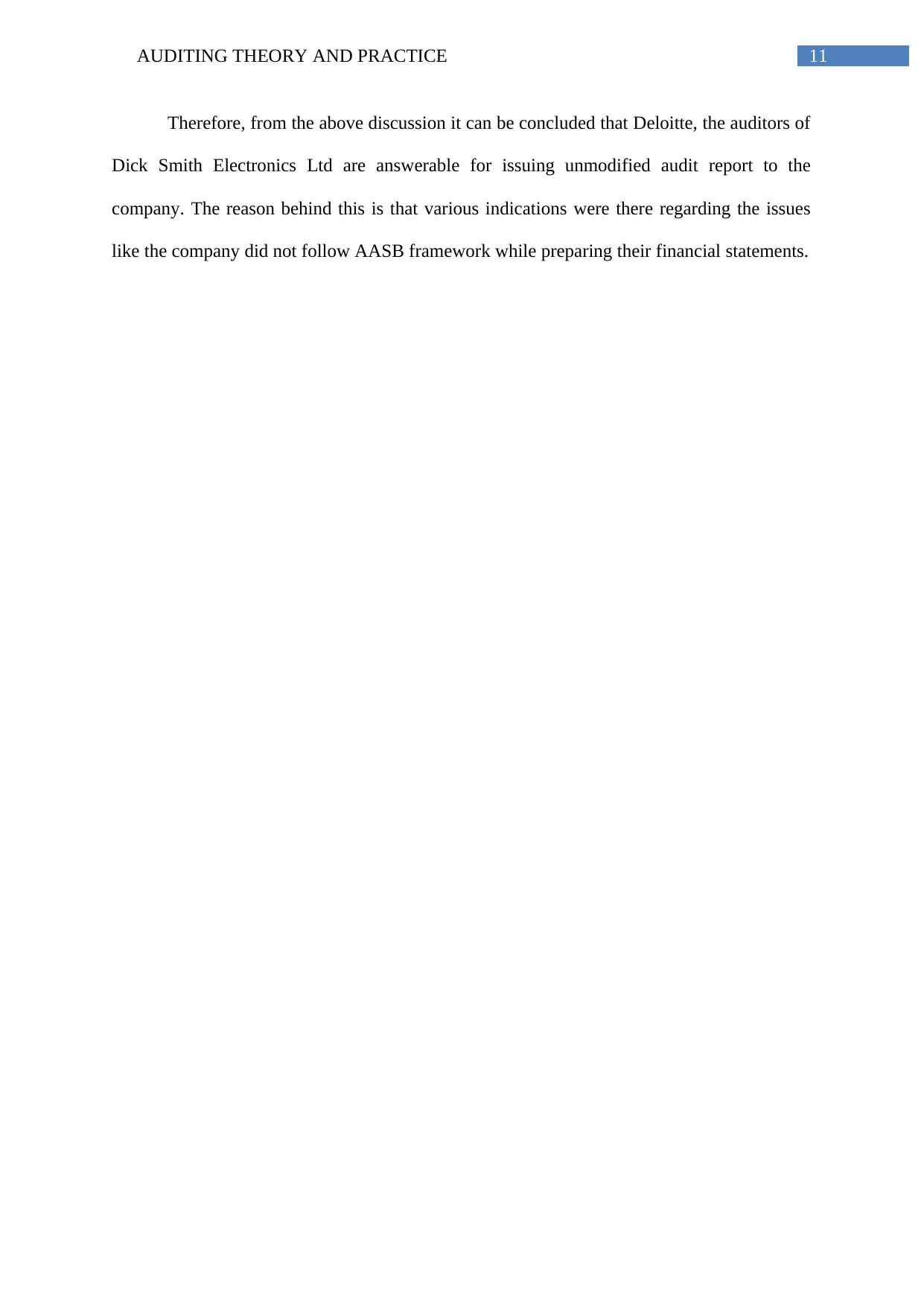
11AUDITING THEORY AND PRACTICE
Therefore, from the above discussion it can be concluded that Deloitte, the auditors of
Dick Smith Electronics Ltd are answerable for issuing unmodified audit report to the
company. The reason behind this is that various indications were there regarding the issues
like the company did not follow AASB framework while preparing their financial statements.
Therefore, from the above discussion it can be concluded that Deloitte, the auditors of
Dick Smith Electronics Ltd are answerable for issuing unmodified audit report to the
company. The reason behind this is that various indications were there regarding the issues
like the company did not follow AASB framework while preparing their financial statements.
⊘ This is a preview!⊘
Do you want full access?
Subscribe today to unlock all pages.

Trusted by 1+ million students worldwide
1 out of 15
Related Documents
Your All-in-One AI-Powered Toolkit for Academic Success.
+13062052269
info@desklib.com
Available 24*7 on WhatsApp / Email
![[object Object]](/_next/static/media/star-bottom.7253800d.svg)
Unlock your academic potential
Copyright © 2020–2025 A2Z Services. All Rights Reserved. Developed and managed by ZUCOL.





